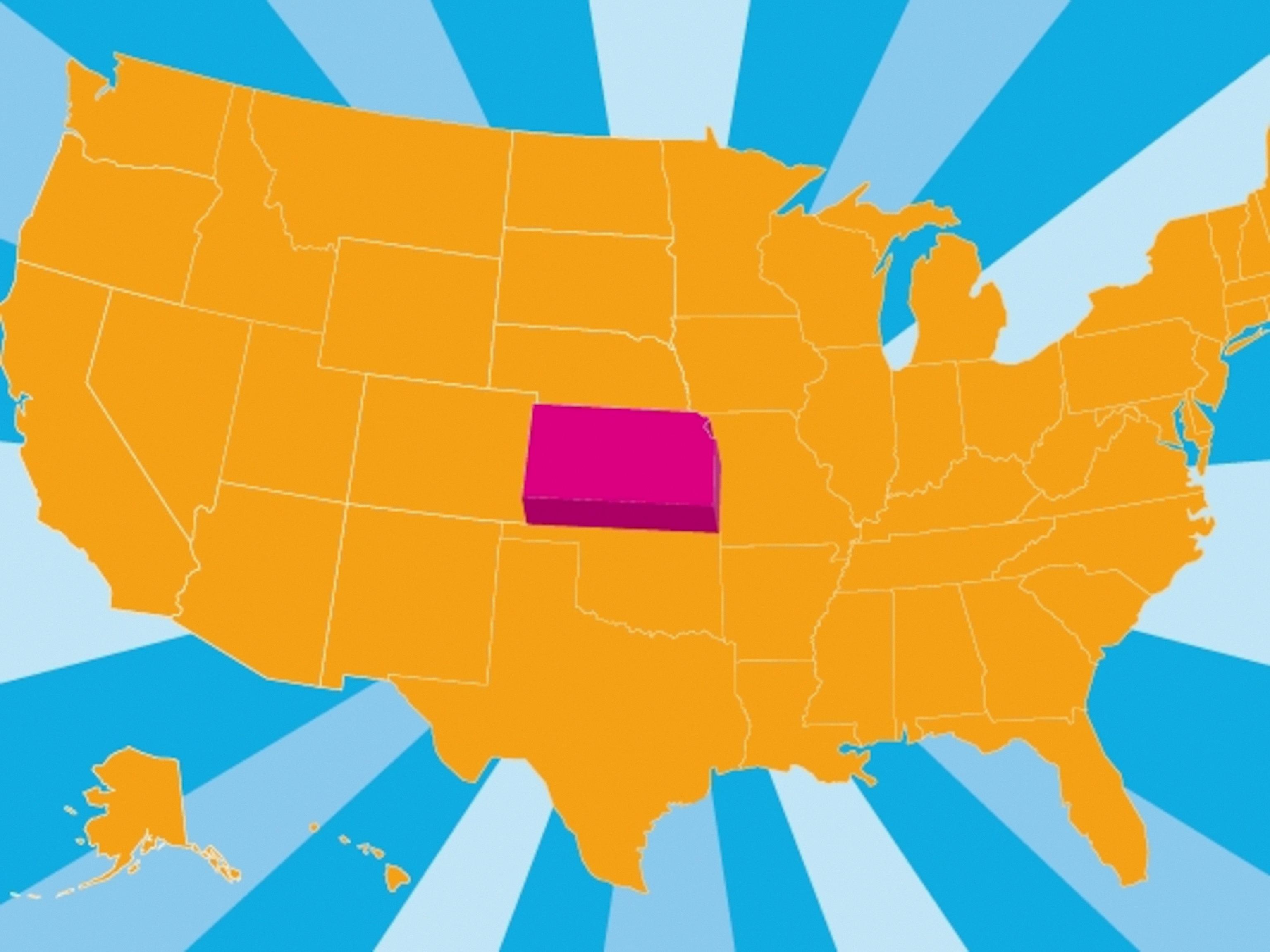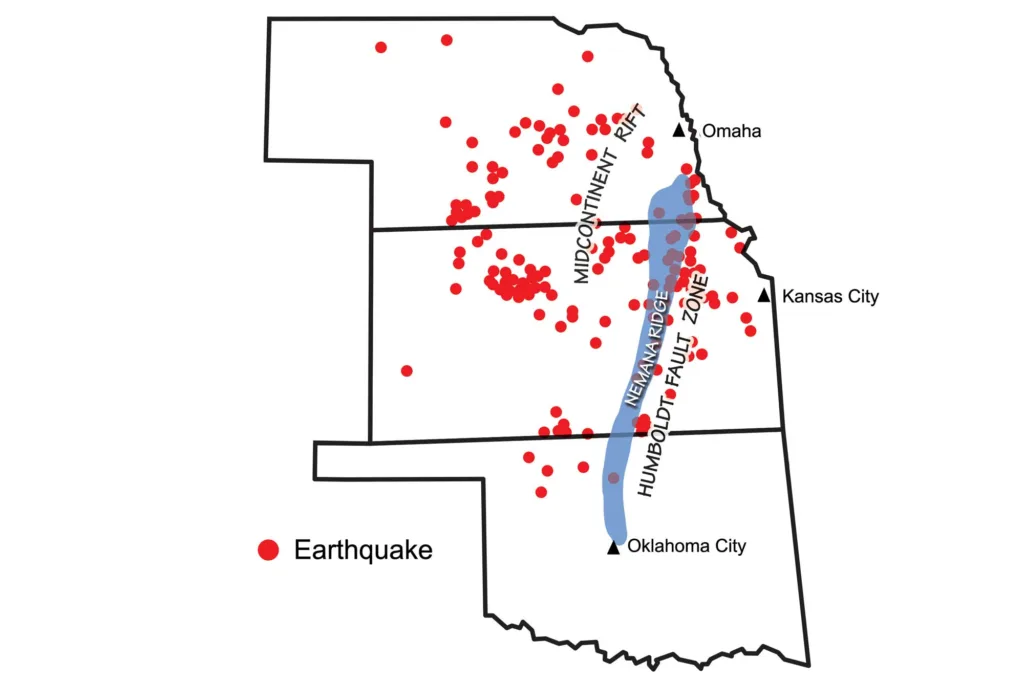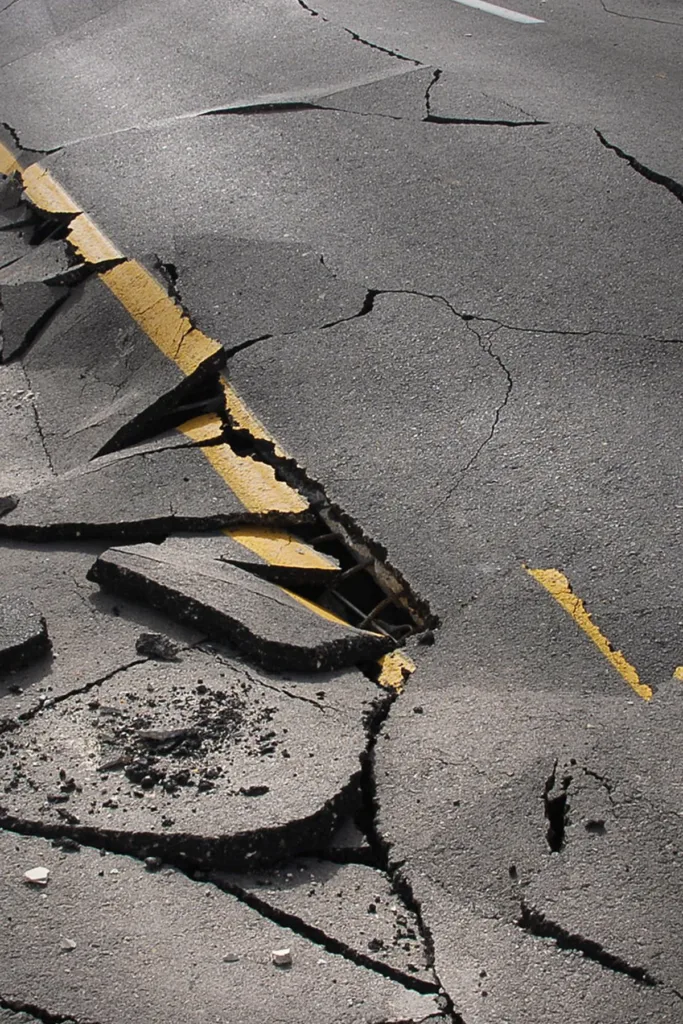Kansas, known as the Sunflower State, may not be the first place that comes to mind when you think of earthquake-prone regions. However, the state does have a fault line that runs through it – the Humboldt Fault.
The Humboldt Fault line starts in Nebraska and extends southeast into Kansas. It is a reverse fault, meaning that the two sides of the fault are pushed together rather than pulled apart. Reverse faults are often associated with earthquakes, but nothing approaching a major earthquake has ever originated in Kansas.
The largest earthquake recorded in Kansas was a 5.1 magnitude quake centered near Manhattan in 1867. While a 5.1 magnitude earthquake is considered “moderate” on the Modified Mercalli Scale of earthquake intensity, it’s still relatively small compared to some of the larger quakes that have occurred in other parts of the country.
West of Kansas City lies the Humboldt Fault and Nemaha Ridge, a buried granite mountain range that extends from Omaha to Oklahoma City. The Nemaha Ridge is a series of buried mountains that were formed during a time when Kansas was covered by a shallow sea. Over time, sediment built up on top of the mountains, and they were eventually buried deep beneath the ground.
Kansas is not particularly earthquake-prone, ranking 45th out of 50 states for the amount of damage caused by earthquakes. However, the north-central part of the state, particularly Riley and Pottawatomie counties, is the most prone to earthquakes. This is due to the Nemaha Ridge, which is closer to the surface in this area and thus more likely to caue earthquakes if there is movement along the fault line.
While the Humboldt Fault and Nemaha Ridge may not make Kansas a hotspot for earthquakes, they are an interesting geological feature that adds to the diverse landscape of the state.
Fault Lines in Kansas
There is one fault line in Kansas known as the Humboldt Fault. It originates in Nebraska and runs southeast into Kansas. Researchers at the University of Kansas have identified reverse faults within the Humboldt Fault. Reverse faults occur when the rock above the fault moves upward in relation to the rock below the fault. While the Humboldt Fault has not caused any significant earthquakes in recent times, it is still an active fault and could potentially cause earthquakes in the future.

Source: kids.nationalgeographic.com
The Largest Earthquake Recorded in Kansas
The largest earthquake ever recorded in Kansas was a 5.1 magnitude quake that occurred near Manhattan in the year 1867. This earthquake is considered moderate in terms of intensity on the Modified Mercalli Scale, which measures the impact and severity of earthquakes. To date, no major earthquake has originated in Kansas, with the 1867 event being the most significant seismic activity on record.
The Location of the Humboldt Fault in Kansas
The Humboldt Fault is located west of Kansas City. It is part of the Nemaha Ridge, wich is a buried granite mountain range that stretches from Omaha to Oklahoma City. The fault itself runs through eastern Kansas, and is characterized by a series of fractures and displacements in the earth’s crust. The Humboldt Fault is of great geological significance, as it marks the boundary between two major tectonic plates – the North American Plate and the Central Plains Microplate. This area is also known for its seismic activity, which is largely associated with the Humboldt Fault and other nearby faults.
The Risk of Earthquakes in Kansas
Kansas is not generally considered to be a state that is prone to earthquakes, as it ranks 45th out of the 50 states in terms of earthquake damage caused. However, there are certain areas of the state that are more susceptible to seismic activity than others. Specifically, the north-central part of the state, including Riley and Pottawatomie counties, has been identified as the region most likely to experience earthquakes. While these earthquakes are typically relatively mild, it is still important for residents of this area to be aware of the potential risks and take appropriate precautions to protect themselvs and their property in the event of an earthquake.
The Increase of Earthquakes in Kansas
Although Kansas is not located near any tectonic plate boundaries, it is still experiencing an increase in earthquakes. This increase is primarily due to human activities such as oil and gas exploration, as well as wastewater injection. During the oil and gas extraction process, fluids are pumped into the ground, wich can cause pressure to build up and lead to the activation of pre-existing faults. Additionally, the disposal of large amounts of wastewater from oil and gas operations into deep wells can also cause an increase in seismic activity. while natural geological structures and faults can also contribute to earthquakes in Kansas, the recent increase in seismic activity can be primarily attributed to human activities in the area.

The Increase in Earthquakes in Kansas
Kansas has experienced several earthquakes due to the presence of the Humboldt fault, which runs along the Flint Hills. While most of the Humboldt fault is not properly aligned to generate significant stress that could cause a quake greater than a 5.5 magnitude, it is still responsible for most earthquakes in the state. Unlike some other states, Kansas is not situated near major tectonic plate boundaries, which are typically the primary cause of earthquakes. However, the injection of wastewater from oil and gas drilling activities into underground disposal wells has been linked to the increase in earthquake activity in the state in recent years. This is because the wastewater increases the pressure in these underground formations, which can trigger earthquakes along the pre-existing faults in the region.
The Status of the ‘Big One’ Earthquake
The Big One earthquake, which refers to a high-magnitude earthquake that is expected to strike California, is considered to be overdue. This is because parts of the San Andreas fault, which is located in a hot-zone of fault lines in California, have not ruptured in over 200 years. Historically, this fault line has experienced high-magnitude earthquakes every 150 to 200 years, which means that the area is currently overdue for another Big One earthquake. While it is impossible to predict when exactly this earthquake will occur, experts suggest that it is important for Californians to be prepared for its potential impact.
The Possibility of a 10.0 Earthquake
There has never been a recorded earthquake with a magnitude of 10.0 or higher. The most powerful earthquake ever recorded was the 9.5 magnitude earthquake that struck Chile on May 22, 1960. This earthquake caused widespread damage and triggered a tsunami that affected the coasts of Chile, Hawaii, Japan, the Philippines, and other countries. While earthquakes of magnitude 9.0 or higher are extremely rare and can cause significant damage, a magnitude 10.0 earthquake is not physically possible due to the limitations of the Earth’s crust and the energy required to generate such a massive earthquake.
Depth of Bedrock in Kansas
The depth of bedrock in Kansas can vary significantly, ranging from as much as 750 feet beow the surface to ground level. This means that in some areas, the bedrock may be relatively close to the surface, while in others it may be located hundreds of feet underground. Understanding the depth of bedrock is important for a variety of reasons, including for the exploration and extraction of natural resources such as oil, gas, and minerals. Additionally, it can impact the availability of groundwater and the potential for groundwater contamination. Therefore, it is essential to have accurate information about the depth of bedrock in Kansas in order to make informed decisions about land use and resource management.

Is Wichita Located on a Fault Line?
Wichita is located near a fault line known as the Nemaha Ridge or Humboldt Fault. This fault line runs through parts of Kansas, Nebraska, and Oklahoma, and has been responsible for several earthquakes in the region over the past century. While Wichita itself is not directly on the fault line, it is located in close proximity to it, which means that it is still at risk of experiencing seismic activity. As a result, residents of Wichita should be aware of the potential for earthquakes and take steps to prepare themselves and their homes in the event of an earthquake.
Causes of Earthquakes in Gypsum, Kansas
Recent studies have suggested that the earthquakes in Gypsum, KS, are likely caused by human activity, specifically the disposal of wastewater through injection wells. When fluids are injected into the earth at significant depths, they can increase the pressure along faults. If this pressure becomes too great, it can overwhelm the frictional forces that are holding the fault in place, resulting in an earthquake. This phenomenon is known as induced seismicity. The Kansas Geological Survey has conducted research that supports this theory and has linked the earthquakes in Gypsum, KS, with the disposal of wastewater through injection wells.
The Most Common Natural Disaster in Kansas
The most common natural disaster in Kansas is floods. Kansas experiences frequent and severe flooding due to its location in the Great Plains, which is prone to heavy rainfall and flash floods. Floods can cause significant damage to property, crops, and infrastructure, and can also result in loss of life. In recent years, Kansas has experienced several major floods, including the 2019 flood that caused over $5 billion in damage and resulted in multiple fatalities. As such, it is important for residents of Kansas to be aware of flood risks and take appropriate precautions to protect themselves and their property.
Natural Disasters in Kansas
Kansas is a state that experiences a variety of natural disasters. It is particularly susceptible to wildfires, tornadoes, floods, and blizzards. These events often result in significant damage to homes, businesses, and infrastructure, as well as loss of life. Despite the challenges posed by these disasters, the people of Kansas are resilient and work together to rebuild and recover in the aftermath.

Source: kcur.org
Is Kansas Part of Tornado Alley?
Not all of Kansas is in Tornado Alley, but the western and central regions of the state are included in this region. Tornado Alley is a region of the United States that is known for experiencing a high frequency of tornadoes, and its boundaries are not strictly defined. However, it generally includes parts of west Texas, Oklahoma, Kansas, Nebraska, South Dakota, and eastern Colorado. In Kansas, the areas that are most frequently affected by tornadoes are those located in the central and western portions of the state, paticularly in the areas near Wichita, Dodge City, and Salina. The eastern portions of Kansas, including Kansas City, experience fewer tornadoes and are not typically considered to be part of Tornado Alley.
Conclusion
While Kansas may not be known for its seismic activity, it does have a lone fault line known as the Humboldt Fault. This fault line extends from Nebraska and moves southeast into Kansas, and contains reverse faults. Although no major earthquakes have originated in Kansas, the state has experienced moderate quakes in the past, with the largest recorded event being a 5.1 magnitude quake centered near Manhattan in 1867. The north-central part of the state, specifically Riley and Pottawatomie counties, are the most prone to earthquakes. While Kansas may rank 45th out of 50 states for seismic activity, it is important to remember that earthquakes can occur anywhere at any time, and it is always important to stay prepared and informed.
